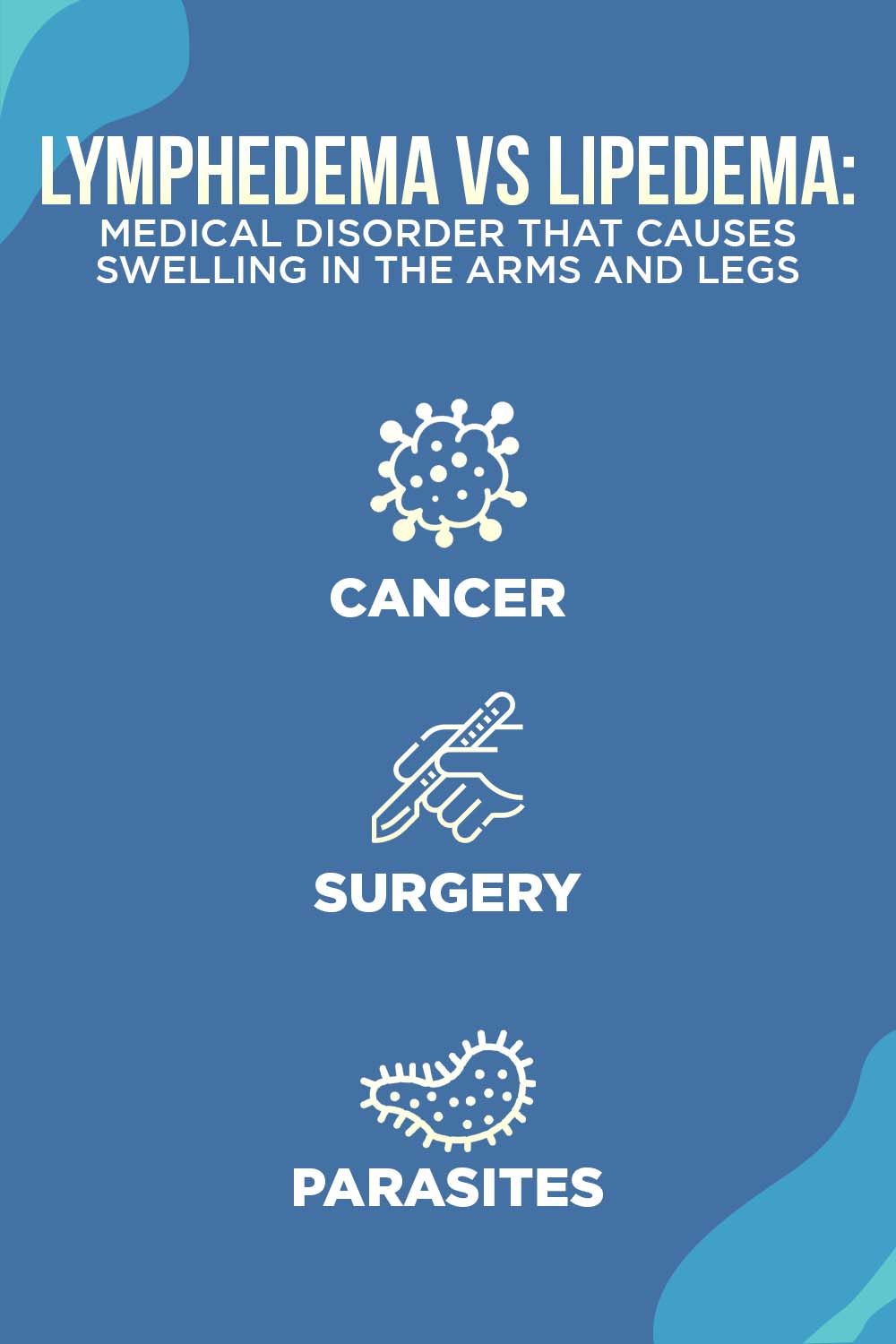
The medical diseases known as lipoedema (sometimes spelled lipedema) and lymphedema are frequently confused with one another due to their similarities. These two illnesses, lymphedema vs lipedema, have very different effects on the body, despite having names that are very similar to one another. It is essential to have a solid understanding of the distinction between lipedema vs lymphedema, in addition to the appropriate management and treatment options available for each.
A chronic condition of fat metabolism and distribution known as lipoedema reveals itself in most cases as an abnormally large quantity of fat being stored in the lower half of the body. Although both men and women can be affected by lipoedema, the condition is far more common in women. Patients who have lipoedema will typically have an abnormally large quantity of fat accumulated in the outer thighs, the inner thighs, the lower legs and ankles, and occasionally the upper arms as well. In more severe cases, the fatty accumulation can be highly disfiguring, which can also lead to difficulties with the joints and movement. It is not known what causes lipoedema; however, the majority of medical professionals believe that it is related to hormones, particularly in women. This is due to the fact that many of the symptoms manifest themselves or become more severe during times of extreme hormonal change, such as puberty, pregnancy, or menopause. Lipoedema is characterized by hormonal changes, frequent bruising of the skin, and the development of tissue that has a rubbery consistency when touched. Lipoedema is a progressive condition, which means that it will get worse as you get older. According to the findings of a few studies, lipoedema may run in families.
The condition known as lymphedema, on the other hand, is characterized by an abnormal accumulation of fluid in the lower legs or arms. The primary difference between lipedema vs lymphedema is that the former is characterized by an accumulation of fatty tissue in the affected areas, whereas lymphoedema is caused by an accumulation of lymph fluid in these tissues. Lymphoedema occurs because of a blockage in your lymphatic system. Because of the obstruction, your lymph fluid cannot drain as it should, which leads to the buildup of extra fluid, which in turn produces swelling. One can classify the causes of lymphoedema as either primary or secondary. A primary cause is one in which the lymphoedema develops on its own, while a secondary cause is one in which it develops as a result of another illness or condition. Primary lymphedema is a rare condition that is passed down through families. It can appear during childhood, adolescence, pregnancy, or, in some cases, after the age of 35. Secondary lymphedema can be brought on by a number of different things, including an infection of the lymph nodes, exposure to radiation therapies for cancer, or damage to the lymph nodes during surgery. It’s interesting to note that lymphoedema can also develop as a subsequent condition to lipoedema. The reason for this is that the extra fatty tissue that occurs in lipoedema can compress and strangle the very delicate lymphatic tracts and veins, which in turn impedes the movement of lymph fluid and causes lymphoedema, also known as a buildup of lymphatic fluid. Those affected by lymphedema suffer from a unique set of symptoms in comparison to those affected by lipoedema. Skin affected by lymphedema is typically more tolerant of touch and does not hurt when it is done so. In addition to this, they are less likely to sustain a bruise and do not have hormone disruption. You can always try vibration plate lymphatic drainage to get better results.
To begin, the names of each of these conditions are spoken and spelled in a manner that is distinct from one another. Lipedema is pronounced “lip-eh-deem-ah,” whereas lymphedema is pronounced, “if-eh-deem-ah.” Both of these conditions affect the body’s lymphatic system. Due to their strikingly similar pronunciations, people frequently get the two conditions mixed up or believe that they are the same illness. The two distinct conditions each have their own unique set of contributing factors. The abnormal buildup of excess fat, known medically as lipedema, most frequently occurs in the legs. Lymphedema is characterized by the buildup of lymph fluids in the tissues, which leads to swelling in those areas. Although there are many variations between the two conditions, it is important to recognize that lipedema can develop into lymphedema over time. It is also important to highlight that neither of these disorders, lipedema vs lymphedema, is caused by a person’s weight or size; however, both are frequently misinterpreted as being associated with obesity.
The typical symptoms include a disproportionately big lower half and column-like legs that are frequently painful and easily bruised. As an illustration, the top half of your body might be a size 8, while the lower half of your body might be a size 16. Your lower body will continue to become heavier as the situation worsens due to the continued accumulation of fat. After some time, fat from lipedema may accumulate in the arms. Over time, fat cells can obstruct the vessels of your lymphatic system, which are generally responsible for maintaining a regular amount of body fluid and protecting you from infection. This obstruction stops the lymph fluid from draining properly, which results in a condition known as lymphedema, which is an accumulation of fluid. If lymphedema is not treated, it can lead to complications such as skin hardening in the legs, infections, and delayed wound healing. Fibrosis, a scar-like tissue, can also form if the condition is left untreated. In contrast to obesity, it primarily affects the legs, thighs, and occasionally the arms. Lipedema, in contrast to lymphedema, begins in the upper legs rather than the lower legs (feet and ankles), and it is not associated with any previous surgical procedures. In most cases, it affects both of the legs.
Lipoedema is a disorder that is frequently diagnosed incorrectly, or even misdiagnosed, and confused with other conditions, most notably lymphoedema, as well as obesity. This happens most frequently in the later stages of the disease when the fat obstructs the lymphatic drainage, which can lead to a mixture of lipedema and lymphoedema, which is sometimes referred to as lipo-lymphoedema. Patients may be offered therapy for lymphoedema in this scenario; however, the underlying lipoedema is frequently ignored by medical professionals. There are many things to do when you are diagnosed with these disorders, but did you know that in addition to boosting your metabolism, decreasing your body fat percentage, and fortifying your bones, the vibration plate may also be used for lymphatic drainage? That’s right! Utilizing the vibrating plate might help you rid your lymphatic system of any built-up fluids or toxins.
A network of tubes known as the lymphatic system is responsible for transporting protein-rich lymph fluid throughout the body. Your immune system includes it as a component. Lymph nodes have a filtering function and are home to cells that fight both cancer and infection. 
Resources: https://www.veinhealth.com.au/whats-the-difference-between-lipoedema-and-lymphedema/ https://patient.info/signs-symptoms/oedema-swelling/lymphoedema-and-lipoedema https://www.drpuneetgupta.co.uk/blog/differences-lymphodema-lipoedema/

Here’s how we use a vibration plate for weight loss...

Many people, especially beginners, notice an itchy or tingling “pins-and-needles”...

Yes, Vibration Plates or Whole Body Vibration (WBV) platforms, promote...

Are vibration machines bad for you? Yes, if used incorrectly....

The lymphatic system, also called the lymphoid system, is an...